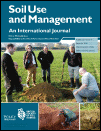Ver ítem
- xmlui.general.dspace_homeCentros e Institutos de InvestigaciónCIRN. Centro de Investigaciones de Recursos NaturalesInstituto de SuelosArtículos científicosxmlui.ArtifactBrowser.ItemViewer.trail
- Inicio
- Centros e Institutos de Investigación
- CIRN. Centro de Investigaciones de Recursos Naturales
- Instituto de Suelos
- Artículos científicos
- Ver ítem
Catabolic response and phospholipid fatty acid profiles as microbial tools to assess soil functioning
Resumen
Microbial properties may help to provide an integrated view of changes in soil functioning associated with soil management or soil status. The fatty acid profiles of membrane phospholipids (PLFA) can give the composition of ecophysiological groups of soil microbial communities, while catabolic response profiles (CRP) estimate the heterotrophic functional diversity in soils, both relevant to the understanding of the role of micro-organisms in the
[ver mas...]
Microbial properties may help to provide an integrated view of changes in soil functioning associated with soil management or soil status. The fatty acid profiles of membrane phospholipids (PLFA) can give the composition of ecophysiological groups of soil microbial communities, while catabolic response profiles (CRP) estimate the heterotrophic functional diversity in soils, both relevant to the understanding of the role of micro-organisms in the functioning of the soil. The objectives of this study were (i) to evaluate the CRP and PLFA as microbial tools to characterize changes in soil functioning and (ii) clarify the relation among these microbial measurements, with other physical, chemical and biochemical soil properties. We compare the same soil subjected to different managements and degrees of erosion. An undisturbed soil (UN), an old pasture soil (OP) and soils under continuous cultivation (NT) with four different depth of A horizon: 25 cm (NT 25), 23 cm (NT 23), 19 cm (NT 19) and 14 cm (NT 14) were tested. Substrate-induced respiration of most substrates diminished when cropping pressure increased (UN > OP > NT), and soil catabolic evenness, as a diversity index, decreased by increasing production pressure and soil erosion. The correlation found among most of the measured physical, chemical and biochemical soil properties with the catabolic evenness showed the potential of this measurement to provide an integrated view of soil functioning. The PLFA analysis showed that the composition of microbial community denoting a partial recovery after 10 yr under grazed grassland. The stress indicators showed that farming practices increased microbial stress with the highest values found in the most eroded soils
[Cerrar]

Autor
Romaniuk, Romina Ingrid;
Costantini, Alejandro Oscar;
Nannipieri, P.;
Giuffré, Lidia;
Fuente
Soil use and management 32 (4) : 603–612. (December 2016)
Fecha
2016-12
ISSN
0266-0032 (Print)
1475-2743 (Online)
1475-2743 (Online)
Formato
pdf
Tipo de documento
artículo
Palabras Claves
Derechos de acceso
Restringido
 Excepto donde se diga explicitamente, este item se publica bajo la siguiente descripción: Creative Commons Attribution-NonCommercial-ShareAlike 2.5 Unported (CC BY-NC-SA 2.5)
Excepto donde se diga explicitamente, este item se publica bajo la siguiente descripción: Creative Commons Attribution-NonCommercial-ShareAlike 2.5 Unported (CC BY-NC-SA 2.5)

